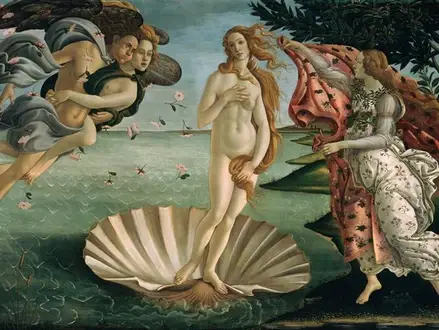Title of Artwork: “The Birth of Venus”

Artwork by Sandro Botticelli
Year Created 1483-1485
Summary of The Birth of Venus
A visit to the Uffizi Gallery in Florence would not be complete without a stop at Sandro Botticelli’s The Birth of Venus, one of the world’s most famous paintings. Commercially, it’s also a symbol of European art.
All About The Birth of Venus
The painting’s subject matter and significance remain a mystery to art critics and viewers alike. There have been many theories and interpretations of this work of art over the ages, proving its complexity.
There is a figure of Venus, goddess of love, standing in a shell washed up on a beach, blown there by two personifications of winds, and welcomed by a maiden on the right. The painting’s composition is quite simple. Venus’ birth is not depicted in the work’s title, which is in contrast to what it depicts.
Her origins are depicted in myth as a child born from sea foam, but the painting depicts her arrival on land. Zephyrus and Aura are unmistakably the wind personifications, the former being impulsive and the latter being measured.
When it comes to her face, the girl’s identity remains a mystery: she could be a symbol for spring or motherhood, or she could be one of Botticelli’s Three Graces. Roses and myrtle branches are both sacred plants to Venus, so she wears them around her waist and around her neck.
Linear and harmonious design, clarity, and brightness of colour are all evident in the painting’s use of gold. We must remember that the painting today is not as beautiful as it was when it was first painted.. In particular, the trees’ greens and the sky’s blue were brighter than they had been before the storm.
From a variety of perspectives, The Birth of Venus is a ground-breaking work. First and foremost, it is a depiction of a nude woman, which was prohibited in the Medieval era – the only exception was an image of Eve in the Garden of Eden. Botticielli captured a stunning image of a naked woman whose gaze is rivetingly fixed on the viewer.
A new genre of painting emerged around 1480 when the mythological themes began to appear in paintings. It’s clear that Botticelli was influenced by classical texts, such as Plinio’s description of Apelles’ painting of Venus rising from the sea or a Homeric hymn about Zephyrus blowing his wind on Aphrodite.
However, Botticelli’s work was influenced by more than just the classical world. With an air of reverence, Botticelli depicted the scene with an air of reverence that reminded him of religious rites, like Verrocchio’s Christ’s Baptism depiction, which he had no doubt seen.
There may be some connection between the mythical birth of goddesses from water and Baptism, as depicted in this iconographic analogy.
Even though there is nothing written about the painting prior to Giorgio Vasari’s description of it in the Medici’s Villa of Castello (owned by the cadet branch of the Medici family since the mid-15th century), it is highly likely that the work was commissioned by a member of the Medici family (perhaps by Lorenzo di Pierfrancesco de’ Medici, a major patron of Botticelli, under the influence of his cousin Lorenzo de’ Medici In the painting, there are orange trees, which are an emblem of the Medici dynasty because of the similarity between their name and the name of the orange tree, which at the time was referred to as’mala medici’.
Information Citations
En.wikipedia.org, https://en.wikipedia.org/.

























